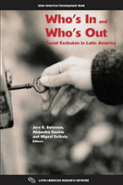Who’s In and Who’s Out: Social Exclusion in Latin America and the Caribbean
Jere R. Behrman
2003
Johns Hopkins University Press for Inter-American Development Bank, Latin American Research Network
Co-Authors: Sojo, Carlos; Behrman, Jere R.; Pérez de Rada, Ernesto; Jiménez, Wilson; Gaviria, Alejandro; Calderón Martínez, Lissette; Alves, Denisard; Teruel, Graciela; Funkhouser, Edward; Pérez Saínz, Juan Pablo; Gray-Molina, George; Székely, Miguel; Lardé de Palomo, Anabella; Rubalcava, Luis; Timmins, Christopher; Parker, Susan W.; Vides de Andrade, Ana Regina
Social exclusion is closely linked with many economic problems in Latin America, as it prevents people from reaching their full productive potential -in turn constraining growth and revenues- and makes them more likely to incur public health and social service costs. Who's In and Who's Out explores various forms of social exclusion, including residential segregation in Bolivian cities, exclusion from health care in Brazil, barriers to legal status of Nicaraguan immigrants in Costa Rica, geographic isolation in El Salvador, and educational inequality among the indigenous in Mexico. The book describes how the exclusion process is exacerbated by self-perpetuating networks of association, prohibitive prices for certain services, and misperceptions between the societal mainstream and excluded groups.
